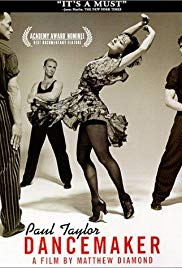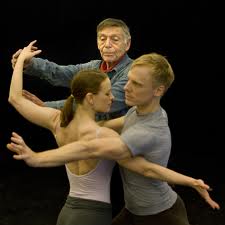DANCEMAKER
SUBJECTS — Biography/Taylor; Dance;
SOCIAL-EMOTIONAL LEARNING — Talent;
MORAL-ETHICAL EMPHASIS — Responsibility.
AGE: 12+; No MPAA Rating;
Documentary; 1998; 98 minutes; Color. Available from Amazon.com.
There is NO AI content on this website. All content on TeachWithMovies.org has been written by human beings.

SUBJECTS — Biography/Taylor; Dance;
SOCIAL-EMOTIONAL LEARNING — Talent;
MORAL-ETHICAL EMPHASIS — Responsibility.
AGE: 12+; No MPAA Rating;
Documentary; 1998; 98 minutes; Color. Available from Amazon.com.
Click here for TWM’s lesson plans to introduce cinematic and theatrical technique.
This documentary covers a year in the life of the Paul Taylor Dance Company. It features the creation of a new dance; endless rehearsals; funding the company; touring India; all leading up to the company’s New York season.
Selected Awards:
1998 International Documentary Association: IDA Award; 1999 Academy Awards Nominations: Best Documentary; 1999 American Cinema Editors Nominations: Best Edited Documentary Film; 1999 Directors Guild of America Nominations: Outstanding Directorial Achievement in Documentary (Diamond).
Featured Actors:
Paul Taylor and Company.
Director:
Mathew Diamond.
“Dancemaker” shows dance as a collaborative art. It highlights the cooperating, yet in some measure opposing, forces which are harnessed to make a dance company: art/money; dancers/choreographers; dancers/management; the limits of the human body/the demands of the art; passion/practicality. Mr. Taylor, the dancers, and the company manager talk intimately about their lives and their work.
MINOR. “Dancemaker” approaches Paul Taylor in an essentially uncritical light and has been called “almost propaganda” by some reviewers. As one reviewer said:
At least a couple of times we are treated to the claim that Taylor is the greatest choreographer of modern dance. Why is such an absolute assertion necessary? It immediately raises questions in the viewer’s mind. What about Taylor’s teacher, Martha Graham? And is Mark Morris chopped liver? Isn’t it good enough to be one of the greatest, without laying claim (and opening a meaningless argument) to being number one? Once the claim is made, too, it puts the filmmaker on the spot to prove it in his film, an impossible task. — Arthur Lazere, Culturevulture.net
Children who are interested in dance will adore this movie. After they have seen the film, go over the origins of modern dance described in the Helpful Background section.

Modern dance began as a reaction against the formal strictures of ballet. Its hallmark is experimentation in finding new sources and forms of movement. Beginning in Europe early in the 20th century, modern dance soon expanded to become a genre in its own right. By 1930, most new developments in modern dance came from the United States, where there had been no strong tradition oballet. Modern dance rejects ballet’s centuries old traditional positions and combinations subsituting movements which come from the emotions of the choreographer, patterns of motion experienced in every day life, or steps from ethnic dances. Examples of the sources of movement that served as the inspiration for modern dance choreographers are: the solar plexus and alternatively resisting and yielding to gravity (Isadora Duncan); dance styles of India, Egypt and Asia (Ruth St. Denis and Mary Wigman), internal sources and natural actions such as breathing and walking (Martha Graham); fall and recovery or words and gestures (Doris Humphrey); and humor and social commentary (Hanya Holm).
After WWII, modern dance continued to develop, exploring ethnic dance and social commentary as sources of movement. It also broke new ground by combining modern dance technique with ballet (e.g., Merce Cunningham). Experiments with movement based upon the spine, spatial relations with other objects, relations with everyday objects, and complex relations with other dancers on the stage were also undertaken. Theatrical effects were sometimes added to supplement the movement of the dancers.
Paul Taylor (1930 – ) trained under Martha Graham, Doris Humphrey, and José Limon. He was a headline performer for many years and won international acclaim when he turned to choreography. His dances are imaginative, at times humorous, and very musical.
The film shows the tremendous physical demands of the art. In one memorable scene, the camera follows a male dancer as he wakes up the day after a performance. This young man, in top physical condition, can hardly move from the beating his body has taken. He is shown staggering into the shower to warm his aching muscles.
1. See Discussion Questions and Projects for Use With Any Documentary.
2. Taylor is referred to as a father figure to his dance company but he has also been called an autocrat. How would you describe the relationship between choreographer and dancer? In your answer, accept or reject two metaphors used in the film: (1) the company is a family and the director is the father or (2) the director is an autocrat and the company must simply do what he tells it to. Use examples from the film to support your position.
1. Taylor said that “I get my energy from being afraid, … afraid to fail.” Do you think that he intended this to be a full explanation for the source of his artistic inspiration? Why would someone have difficulty explaining the source of his artistic inspiration?
Discussion Questions Relating to Ethical Issues will facilitate the use of this film to teach ethical principles and critical viewing. Additional questions are set out below.
(Do what you are supposed to do; Persevere: keep on trying!; Always do your best; Use self-control; Be self-disciplined; Think before you act — consider the consequences; Be accountable for your choices)
1. Would Paul Taylor have been able to achieve prominence in the dance world without having acted according to this Pillar of Character?
This Learning Guide was last updated on March 1, 2011.